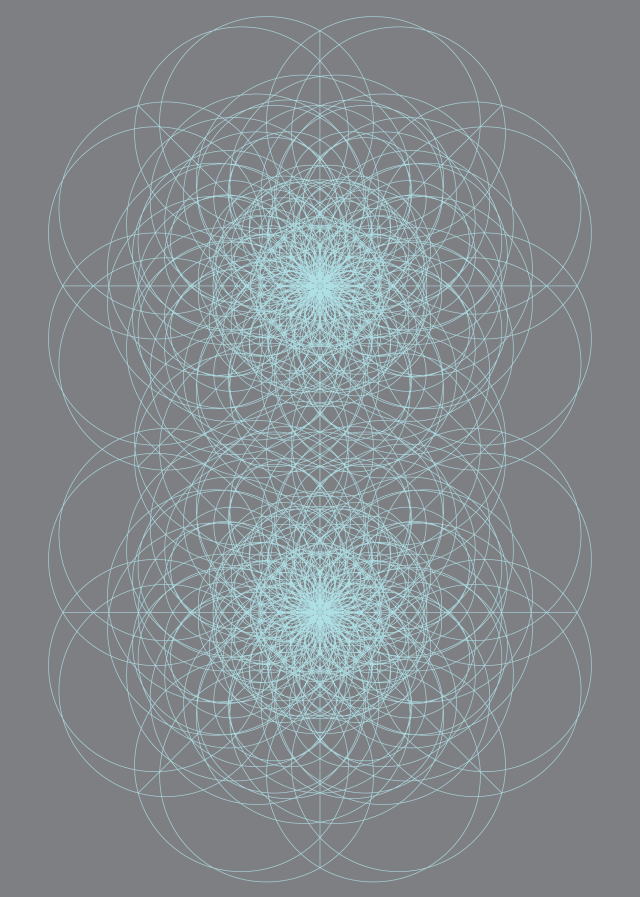The sculpture covered at the beginning of this investigation's total development
is this sitting buddha in early-Mathura-school India.
This sculpture appear as a construction pervaded with strong extensity like stretching to outer air,
due to a spatial composition fusing all elements rationally.
It seems proper that there is some sort of logic about architectonics.
Finding out it's bottom is not so difficult.
A simple application of pentagram is be clear after any practice.
The particular location of pentagram that vertexes are putting on the top of halo,
head ornaments of each bodhisattva, and buddha's finger, is perceived.
It seems viewable that the head ornament of right side bodhisattva is moved to his right temporal
in order to correspond pentagram, by strong-arm way.

high-jpg
Developing the investigation, the forecast that this sculpture's prescript may be more rigorous legitimate integral, came up.
On widening of such intuition, the most fundamental diagram constructed from 8 circles, which provided this sculpture, had found.
Concretely speaking, the diagram is the circle construction as the practice to draw pentagram in just proportion.
The figure explaining such situation is shown below. Explanation of this diagram's system →here

The figure overlapped such diagram on the sculpture,
in the same alignment of the case overlapping only pentagram, is shown below.

high-jpg
There must be some kind of logical relation between the matrix found so far as a simple composition of only circles
and the halo circle carved in this structure.
Carrying on exploration, the economic method to join the same reduced matrix's unit in the inner area, had found.
The expansive status of matrix appeared by performing on such join-method, is shown below.
Explanation for this method on matrix →here

The figure overlapped the 2-step jointing diagram on the sculpture, is shown below.
It is sure on this view, that the certain circle in the second step unit shifting from the circumcircle of pentagram in the first step unit
corresponds the circle's outline of the halo.

high-jpg
The figure emphasizing the circumcircle of pentagram in the first step unit and the successive circle
in the second step unit, to grasp relation of them, is shown below.

high-jpg
It is able to repeat the same process as reducing-join.
The figure coming from 3-step joint process, is shown below.

The figure overlapped the matrix's status of [3-step reducing-join] on the sculpture,
as the consistent alignment so far, is shown below.

high-jpg
The figure emphasizing pentagram and it's circumcircle,
for understanding of such relational position in the 3-step join diagram, is shown below.

high-jpg
It is able to connect some units of [3-step reducing join] in a radial pattern, sharing concentric circles.
The fact that this connecting method is completed as the technique of making up ancient disks,
exemplified by Celtic disks and Chinese mirrors before Mahayana epoch.
This view is found from presciences in divaricate investigative domains.. →reference
In addition, it is taken hold on already that certain standing buddha sculpture of Gupta-Mathura school
is architected corresponding a vertical connection of [8-radial connecting units]. →reference
The figure describing a matrix's standard status in Gupta age as high-class connect method, is shown below.
The integrated explanation about this status of matrix, is developing at the individual site for matrix system.→here

The figure overlapped the diagram of such high-class connection
as the consistent alignment of practices so far on the sculpture, is shown below.

high-jpg
The closeup figure of the sculpture's area in above figure, is shown below.
It seems sure that this matrix's expansive status is providing the sculpture all over,
covering even details of outer area elements specifically,
as exemplified by standing bodhisattvas, flying bodhisattvas, buddha's pedestal and tree branches.

high-jpg